The decision to remove the barn was not made in haste.
It began with issues that implicated the design and
location of Mitchell Bridge. There were two
traffic-crossing points on the north end of track. A
small road crossed the surface between turns 13 and 14
and headed straight into the competition paddock. But,
the path was closed much of the day while cars were on
the course.
The other traffic route wandered away from the paddock
to Mitchell Bridge, which crossed over turn 13 at
Fireman's Hill, then ran back toward the paddock, much
like a detour. The bridge's load capacity and narrow
lanes were less than ideal, especially with big rigs
carrying multiple cars and heavy equipment. It was the
only route open during racing on the north end.
On the track itself, Mitchell Bridge was a major hazard
staring drivers in the face on every lap. It was poorly
located at the apex of turn 13, which was somewhat of a
blind uphill bend driven flat out. The vertical concrete
abutments were only as far apart as the width of the
course, which was originally paved at 27-feet. It was
the site of some violent wrecks in previous years.
Track officials and owners decided it was time for the
bridge to go. It was part of a large-scale improvement
plan to remove the hazard and address the problem of
moving traffic through the area, especially with the
closing of a major route. The only practical solution
was to build a traffic tunnel crossing under the track,
right on the old paddock road. It also involved
relocating the competitor's entrance located by the old
farmhouse and barn, so it was in alignment with the
existing paddock road. It created the axis needed to
address the flow of traffic. The realignment afforded
race rigs a straight shot into the paddock without the
hassle of negotiating turns.
Like any development story, the barn and silo were
standing in the way of progress. It was a vital route
needed to feed Road America like car starved of fuel.
The cost of the entire project was $1.5 million, which
included removal of Mitchell Bridge, the silo and barn
with its scoreboard. In December 2006, excavation began
for the new tunnel. They dug a trench right through the
stretch of track between turns 13 and 14. All the work
was completed in Spring 2007. |
|
|
|
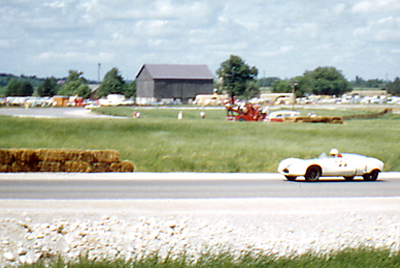
| One of the earliest
photos of the barn before it was touched.
The silo is behind the tree. Photo taken a
year after the track opened. The white
Modified class car is on stretch between
Turns 5 and 6. The barn is on a parallel
backstretch that runs between Turns 13 and
14. June Sprints SCCA National - June
23-24, 1956 |
|
|
|
|
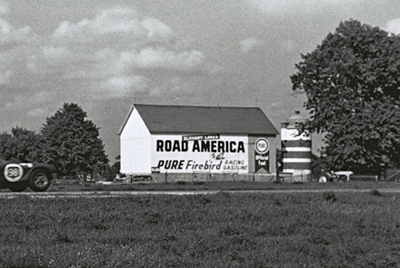
| Looking northeast at
barn on stretch of track between T 13 and
14, with AC Cobra approaching T14l. The ad
reads Pure Firebird Racing Gasoline, long
before the scoreboard was added. Road
America 500 - September 9, 1963 |
|
|
|
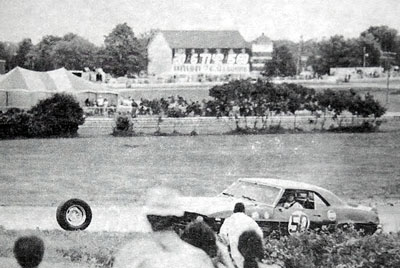
| Anyone see a wheel
rolling around here? This is earliest photo
I have of the scoreboard on the barn across
the infield. Photo (looking northeast) from
hill at Turn 5, during SCCA Trans-Am
Over-2-Litre race on Sunday, July 19, 1970. |
|
|
|
|
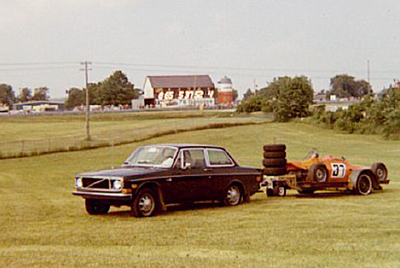
| Same photo angle with
scoreboard on barn, along with Union 76
Gasoline ad. Paddock is in foreground with
Volvo sedan towing formula car. These were
simpler times when it was more affordable to
achieve your dreams of racing. - circa. 1972 |
|
|
|
|
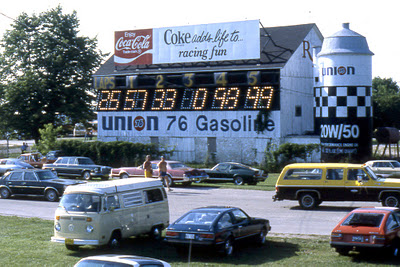
|
The scoreboard on
south wall of barn at the north side of
track. Displayed are the results of a 25 laps race and
top five finishers.
SCCA Trans-Am 100 mi race -
Saturday, July 19, 1980. (Photo by Mark Windecker)
|
|
|
Mounted on the barn's
south wall was a big scoreboard illuminated by 333
lamps. It displayed the lap number and
positions of the five
leading cars. It was highly visible and
convenient for spectators sitting on Fireman's Hill
and could be seen about a half-mile away from the
paddock.
Each number was about 5
feet in height. Despite a few burnt out bulbs the board
reads, 25 laps, followed by car numbers 25, 57, 33, 0,
98, and 99. This photo shows the results of the Trans-Am
race on Saturday, July 19, 1980. On the barn's gable end
wall behind the silo are the letters R A for Road
America, which was the track's original logo from 1955. |
|
Race Results
SCCA Trans-Am - July 19, 1980
|
Pos |
Driver |
No |
Car |
Entrant |
Money |
|
1st |
Monte Shelton |
57 |
Porsche 911SC |
Porsche-Audi Northwest |
5,000 |
|
2nd |
Mark Pielsticker |
33 |
Chevrolet Monza
Gallant 002 |
IH Distributor Team |
3,500 |
|
3rd |
Roy Woods |
0 |
Chevrolet Camaro |
Rocky Mountain
Performance |
2,000 |
|
4th |
John Bauer |
98 |
Porsche 911SC |
Green Racing |
1,500 |
|
5th |
Phil Currin |
99 |
Chevrolet Corvette |
Full Time Racing |
1,200 |
|
|
|
|
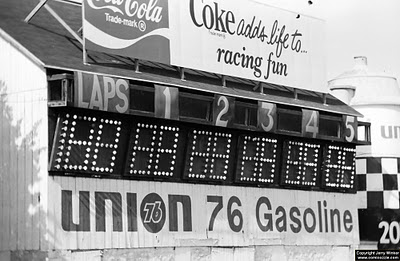
|
The scoreboard up close showing flood lamps used. There
are 27 used for each number with a total of 333 lights
used on the entire display. It is controlled by timing
and scoring located at nearby T14. Barely visible
numbers show top five finishers of the SCCA Can-Am
race on July 26, 1981.
(Photo by Jerry Winker) |
|
|
LAPS |
1
|
2 |
3 |
4 |
5 |
|
40 |
3 |
1 |
5 |
14 |
25 |
(Numbers from photo of scoreboard
above)
Race Results
SCCA Can-Am - Sunday, July 26, 1981
|
Pos. |
Driver |
No. |
Car |
Entrant |
Money |
|
1st |
Geoff Brabham |
3 |
Lola T530 |
Racing Team V.D.S. |
$21,000
|
|
2nd |
Jeff
Wood |
1 |
Lola
T530 |
Carl
Haas, |
$12,000 |
|
3rd |
Al
Unser |
5 |
March 817 |
Paul
Newman |
$8,000 |
|
4th |
Al
Holbert |
14 |
Holbert CAC-2 |
CRC
Chemicals |
$6,700 |
|
5th |
Jim
Trueman |
25 |
Ralt
RT2 153 |
Red
Roof Inns |
$7,100 |
|
|
|
|
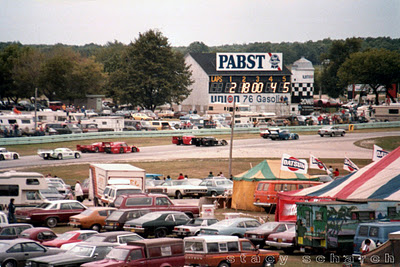
View from turn 5 on side of Fireman's Hill (looking
northeast) at barn, scoreboard and silo. IMSA GTP,
GTO and GTU cars are on pace lap approaching T 14 before
start of the Pabst
500, IMSA GT race on August 22, 1982. (Photo by
Stacy Scharch) |
|
|
I took this photo during the pace lap for the 1982 Pabst
500 IMSA Camel GT endurance race on Sunday, August 22,
1982. The scoreboard shows the order of the cars that
qualified for the starting grid. (ABOVE) The display for
laps is empty because cars are on a pace lap. Passing in front of
the barn at slow speed the GT cars head toward T 14, the
final corner turning onto the main straight, which
climbs the hill and drivers anticipate seeing the green
flag waved at the last second. The Pabst sign was the
new sponsor added to roof of barn in 1982. Augie Pabst,
heir to beer fortune, was a serious driver and raced at
R/A in the 1950s and
1960s. He has long been an ambassador and supporter of Road American
and the Elkhart Lake Historic Race Circuits. |
|
LAPS |
1
|
2 |
3 |
4 |
5 |
|
|
2 |
18 |
00 |
4 |
5 |
(Numbers
from photo of starting grid above)
Starting Grid
IMSA Camel GT - Sunday, August 22,
1982
|
Grid |
No. |
Drivers |
Car |
Entrant |
|
1st |
2 |
John Fitzpatrick /
David Hobbs |
Porsche 935 K4 |
John Fitzpatrick
Racing |
|
2nd |
18 |
John Paul / Hurley
Haywood |
Porsche 935 JLP-4 |
JLP Racing |
|
3rd |
00 |
Ted Field / Danny
Ongais |
Lola T600 Chevrolet |
Interscope Racing |
|
4th |
4 |
Chris Cord / Jim
Adams |
Lola T600 Chevrolet |
Rayfin, Inc. |
|
5th |
5 |
Bob Akin / Derek
Bell |
Porsche 935 L |
Bob Akin Motor
Racing |
Race Results
IMSA Camel GT - August 22,
1982
|
Pos |
Drivers |
No. |
Car |
Entrant |
Money |
|
1st |
John Fitzpatrick /
David Hobbs |
2 |
Porsche 935 K4 01 |
John Fitzpatrick
Racing |
$19,000 |
|
2nd |
John Paul Jr. /
Maurico DeNarvaez |
46 |
Porsche 935 JLP-3 |
JLP Racing |
|
|
3rd |
Bob Tullius / Bill
Adam |
44P |
Jaguar XJR-5 001 |
Group 44 |
|
|
4th |
Chris Cord / Jim
Adams |
4 |
Lola T600
HU5/Chevrolet |
Rayfin, Inc.
|
|
|
5th |
Dave Cowart /
Kenper Miller |
25 |
March 82G 2/BMW |
Red Lobster Racing |
|
|
|
|
|
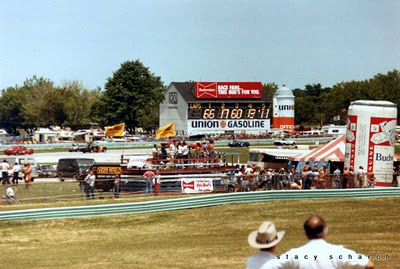
|
Same vantage point from inside turn 5 looking northeast
at barn and scoreboard. Production class cars are on pace
lap approaching turn 14 during start of race at June Sprints SCCA National on June 22-24, 1984. (Photo by Stacy
Scharch) |
|
|
By 1984, the barn had a Budweiser sign on the roof.
(ABOVE) The Union 76 sponsor remained as it had for several
years, but the bottom half of the silo was changed to
red and removed
the 20W/50 oil viscosity. Maybe there too many differing
opinions over what oil weight to dump in your car. |
|
|
|
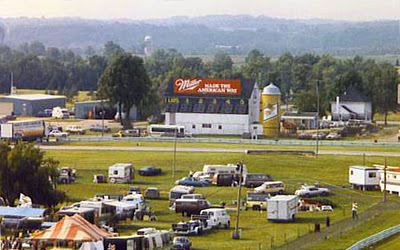
View from main paddock (looking northwest) at the barn and
scoreboard between turns 13 and 14 in 1989.
From left to right: blue metal
garage buildings, barn, silo
and the old farmhouse (extant). The
approach for the tunnel now goes through middle of barn
and under track. |
|
|
(ABOVE) The north end of track showing location of barn and silo.
The 4-mile road course runs in front of barn. The
infield is the paddock for competitors tow vehicles, car
haulers and campers. At far right is the backside of the
timing and scoring shack with trailer add-on attached.
It setup was positioned on the inside of turn 14 (out of
picture). |
|
|
|
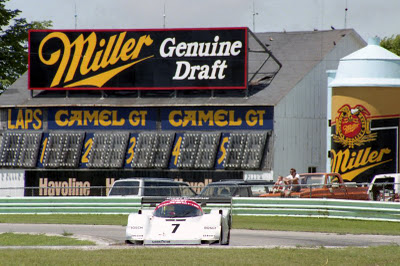
|
View looking northwest at barn and silo. In the
foreground is a GTP car on the apex in the middle
of turn 14. Miller beer and Havoline oil were displayed
barn during the Piggly Wiggly Grand Prix 500 k race in
1993. (Photo by Mark Windecker) |
|
|
Exiting turn 14 is the GTP Porsche 962C prototype car of Joest Porsche
Racing. Co-drivers, Winter/Reuter drove #7 to victory in the Piggly Wiggly Grand Prix, IMSA GT
endurance race on Sunday, July 11, 1993. |
|
|
|
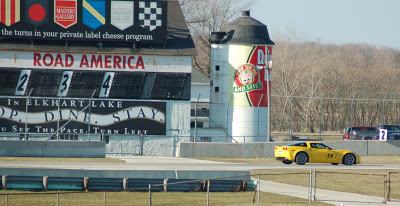
| The old barn in its
final regalia.
The track is now lined with containment
fence and concrete barrier walls to protect
drivers, spectators and workers. (Spring
2006) |
|
|
Much of the track's natural wonder is gone. In the name
of safety, Road America's scenic road course slowly
changed from the look of an old countryside road to more of
an urban freeway. The course itself has remained
unchanged, but is safer for drivers, track personnel and spectators. |
|
|
|
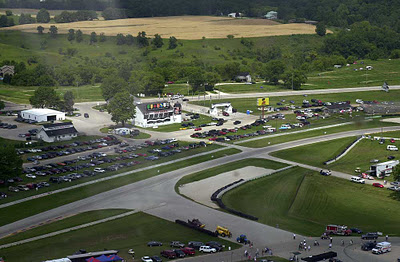
| Aerial view looking northeast at the road
course, running from lower left to middle right in
photo. The barn, scoreboard and silo are at
center. The narrow paddock road runs
diagonally across the track where the tunnel
was laid. Photo from 2006. |
|
|
Road circuits saw several safety
updates over the years, including large run-off areas,
tire walls with concrete barriers and a lot of
containment fence.
At the center of photo is a gravel trap, which helps
reduce speed of cars skidding off course. Tire walls (in black) line the
face of new concrete barriers to help cushion any
impact. |
|
|
|
Tunnel Project
Road America's Big Dig |
|
|
|
The main gate on highway 67 was used by competitors and
race officials to gain entry to Road America's 628-acre
facility. But, the old barn stood in the way of plans
for a new main entrance point into the paddock. A tunnel
was the ideal answer for moving a traffic, which would
also increase after removal of the 1955 Bill Mitchell
bridge.
On December
5, 2006 Road America began a $1.5 million construction
project, which included the addition of a new tunnel to
the paddock and the removal of the Bill Mitchell bridge.
The project was part of the track’s long-range facility
improvement plan. The new tunnel is located
approximately 100 yards south of the farmhouse office.
It was placed between turns 13 and 14, right where the
old paddock road crossed the track surface and allowed
unfettered access to track's infield.
The tunnel
was designed to accommodate two lanes of vehicle traffic
and two pedestrian walkways, it has a 16-foot clearance,
is 36-feet wide and 168-feet long. McMahon and
Associates of Neenah, Wisconsin, designed the tunnel and
Lunda Construction Co. was the general contractor. The
pre-cast concrete roofing structure enabled the tunnel
to be ideally located near the farmhouse office and Gate
1, which became the main entrance point into the
paddock. Installation of the tunnel was completed in
April 2007. The track section above it was replaced and
appears as though it had never been disturbed. The new
Kohler Tunnel was dedicated on June 1, 2007. |
|
|
|
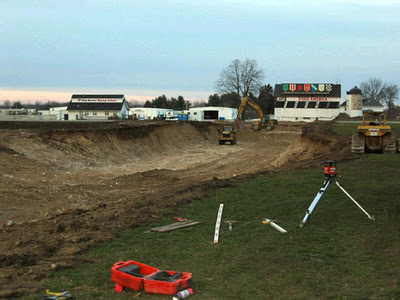
|
Tunnel excavation began December 5, 2006 and is well underway. The view (looking north) down the trench,
which cuts through the track just before T 14. In the
middle of the path is the barn, which was
demolished along with the silo in February 2007. |
|
|
Unfortunately, the old barn had to go in order to make
way for the new traffic tunnel and route into the
paddock. It was part of a $1.5
million improvement project, which removed the hazardous bridge at turn 13 and streamlined
the flow of traffic entering the paddock infield. |
|
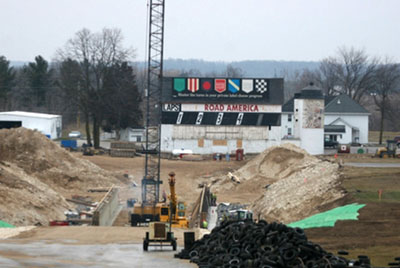
|
Footings have been poured and forms for walls
are up. (January 12, 2007) |
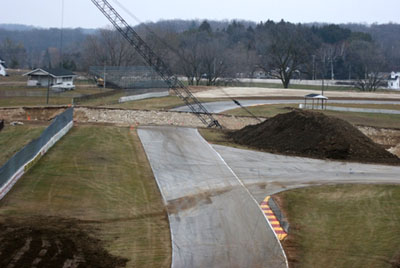
|
Looking east at tunnel trench where it cuts
through the track at the entrance to Turn 14.
(January 12, 2007) |
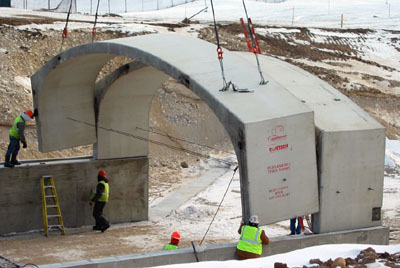
|
Precast sections being set at south end.
(February 6, 2007) |
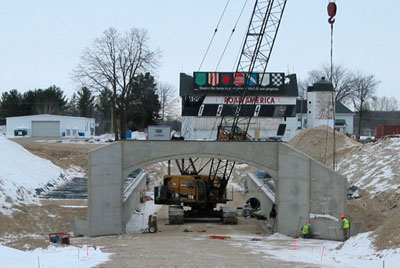
|
Looking north at south end precast wall panels
being set. (February 6, 2007) |
|
|
|
|
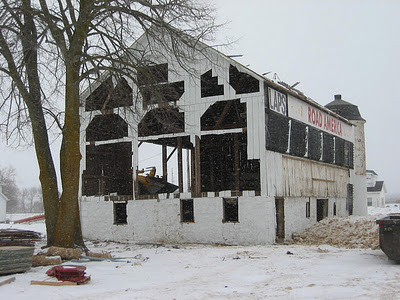
|
The Road America barn, silo and scoreboard during demolition
on Feb. 13, 2007.
The tree actually survived and is now
surrounded by asphalt and what is now a busy
intersection on the track's outer perimeter. |
|
|
The barn was right in the path of the tunnel's north end and
was one of Road America's busiest intersections. It is
where wall roads meet on the track's north side, and a
point of access to the infield paddock. |
|
|
|
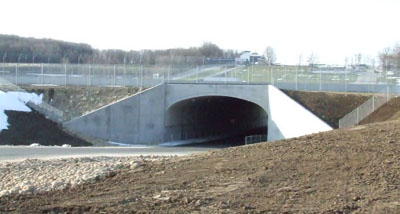
|
Northern portal of new tunnel between T 13 and T 14
where it crosses under the track into the paddock. Race
control building is the structure at the center of
hillcrest above tunnel opening. (April 2007)
|
|
|
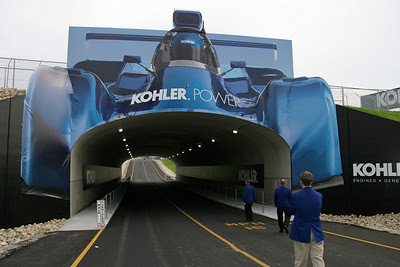
| The northern portal of the
new Kohler tunnel as it
receives one final inspection before the grand opening
celebration
on June 1, 2007. |
|
|
The underpass supports an overpass for the road course
and its speeding racecars. It is located between turns
13 and 14. The tunnel is built of multiple precast
concrete sections spanning 36-feet. It accommodates two
lanes of traffic and two pedestrian walkways, which is
twice that of the old Mitchell bridge. The rise is also
taller at 11-feet, and the portal is 168-feet in length. |
|
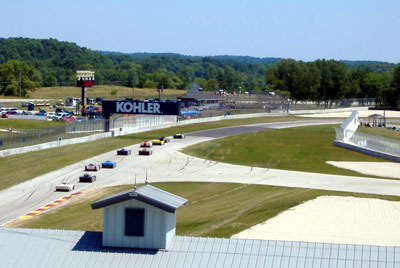
|
The
first season with new Kohler tunnel in place. A gaggle of Spec Racer
Fords approach a new patch of asphalt on track where the
tunnel is located and was backfilled.
June Sprints SCCA National on
June 21-24, 2007 |
|
|
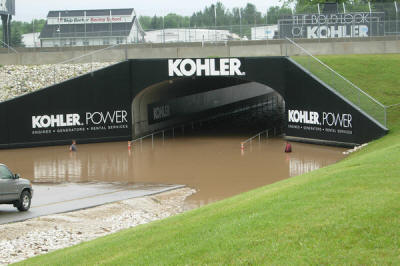
|
South end of tunnel (looking north) flooded
during heavy rains in June 2010. A stranded
truck is unable to exit paddock. Two men
are standing waist deep in water on side of roadway. |
|
|
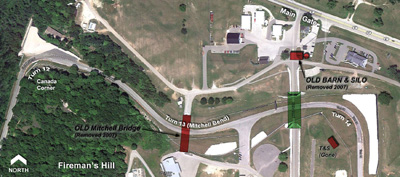
|
Satellite view of track's north side
showing location of the old barn, silo and bridge in
red. The tunnel is in green. (ca. 2011) |
|
|
The original 4-mile, 14-turn
track configuration has never been altered. Millions of
dollars in improvements have been spent throughout the
years, since the renowned racing circuit opened in 1955.
There is a new office, registration and race control
buildings, as well as the Road America Center. Several
small
concession stands built of concrete block are dotted
around the grounds and original to the track. |
|
|
|

